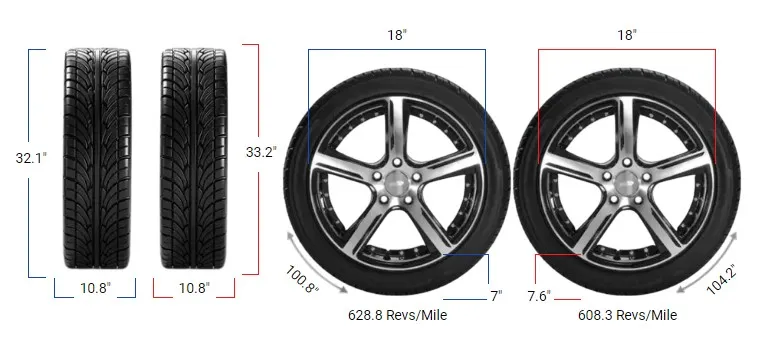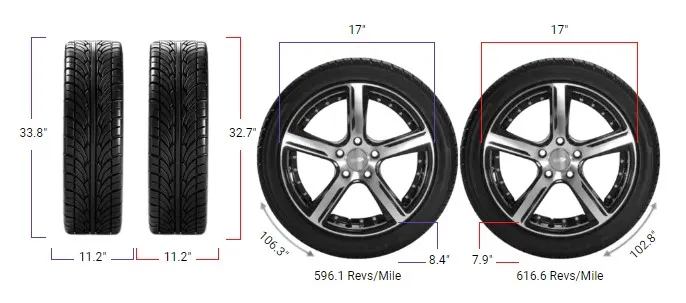Tire Size 215/45r17 vs 215/50r17

Switching from 215/45r17 to 215/50r17 tires can give your vehicle a subtle lift and slightly altered driving dynamics. Let’s dive into what this means for your car’s performance and handling.
- Increased sidewall height provides a smoother ride
- Slightly improved ground clearance for navigating rough roads
- Speedometer will read about 1 mph slower than actual speed at 20 mph
- Potential for improved fuel efficiency with fewer revolutions per mile

Fitment Guide
In this case, moving from 215/45r17 to 215/50r17 results in a 3.4% increase, slightly exceeding the recommended range. While it may still work, be cautious of potential rubbing or clearance issues.
On-Road Impact
Taller sidewalls can significantly influence your vehicle’s on-road behavior. Here’s what you might notice:

- Ground Clearance: The 21.5mm increase in diameter translates to about 10.75mm of added ground clearance. This extra height can help navigate rough roads or minor obstacles more easily.
- Ride Comfort: With more tire volume to absorb bumps and vibrations, you may experience a smoother, more comfortable ride. The taller sidewalls act as an additional cushion between the road and your suspension.
- Speedometer Accuracy: Because the new tires have a larger circumference, your speedometer will read slightly slower than your actual speed. At 20 mph, you’ll be moving at 20.69 mph. Keep this in mind to avoid unintentional speeding.
- Fuel Economy: The 3.3% reduction in revolutions per mile means your engine will turn fewer times to cover the same distance. This could lead to a minor improvement in fuel efficiency.
- Aesthetics: The taller sidewalls will fill your wheel wells more, giving your vehicle a subtle lift and a more rugged appearance.
Off-Road Impact
If you venture off the beaten path, here’s how the tire switch might affect your experience:

- Traction: The larger contact patch provided by the taller sidewalls can enhance traction on loose or uneven surfaces, giving you better control and stability.
- Durability: With more rubber to absorb impacts, the 215/50r17 tires may be more resistant to punctures and damage from rocks or debris.
- Steering Response: The taller sidewalls might slightly diminish steering responsiveness due to increased tire flex. This could be noticeable during quick maneuvers or when navigating tight trails.
215/45r17 vs 215/50r17
| Feature | 215/45R17 | 215/50R17 | Difference |
|---|---|---|---|
| Diameter inches (mm) | 24.62 (625.3) | 25.46 (646.8) | +0.85 (+21.5) +3.4% |
| Width inches (mm) | 8.46 (215) | 8.46 (215) | 0 (0) 0% |
| Circumference inches (mm) | 77.34 (1964.44) | 80 (2031.98) | +2.66 (+67.54) +3.4% |
| Sidewall Height inches (mm) | 3.81 (96.75) | 4.23 (107.5) | +0.42 (+10.75) +11.1% |
| Revolutions per mile (km) | 819.24 (509.05) | 792.01 (492.13) | -27.23 (-16.92) -3.3% |
| Speedo Reading | 20 mph (32.19 km/h) | 20.69 mph (33.29 km/h) | +0.69 mph (+1.1 km/h) |
What is the Main Difference Between 215/45r17 and 215/50r17 Tires?
The primary difference lies in the sidewall height, with 215/50r17 tires having a 11.1% taller sidewall compared to 215/45r17 tires. This results in a 3.4% larger overall diameter while the width remains the same at 215mm.
Can I Use 215/50r17 Instead of 215/45r17?
While you can potentially use 215/50r17 tires in place of 215/45r17, the 3.4% difference in overall diameter slightly exceeds the typically recommended range of 3%.
This could lead to rubbing or clearance issues in some cases, so it’s best to consult with a tire professional for your specific vehicle.
How Much Taller is a 215/50r17 Tire Than a 215/45r17?
A 215/50r17 tire has a sidewall height that is 10.75mm or 0.42 inches taller than a 215/45r17 tire. This translates to an overall diameter increase of 21.5mm or 0.85 inches, which is about 3.4% larger than the 215/45r17 size.
Our Observation
While stepping up to 215/50r17 tires offers some benefits like improved ground clearance, ride comfort, and off-road capability, it’s crucial to consider the potential drawbacks. The 3.4% difference in diameter is just beyond the typically recommended 3% range, which could lead to rubbing or clearance problems in some cases.
For on-road use, the changes in speedometer accuracy and steering response may take some getting used to. However, the improvements in ride quality and minor gains in fuel economy could make it worthwhile for some drivers.
If your vehicle sees a mix of on-road and off-road action, the enhanced traction and durability of the taller sidewalls could prove beneficial. Just be prepared for a slight reduction in steering precision when navigating challenging terrain.
Ultimately, whether the switch from 215/45r17 to 215/50r17 tires is right for you depends on your specific vehicle, driving habits, and personal preferences. It’s always wise to consult with a trusted tire professional to ensure proper fitment and optimal performance for your unique setup.



